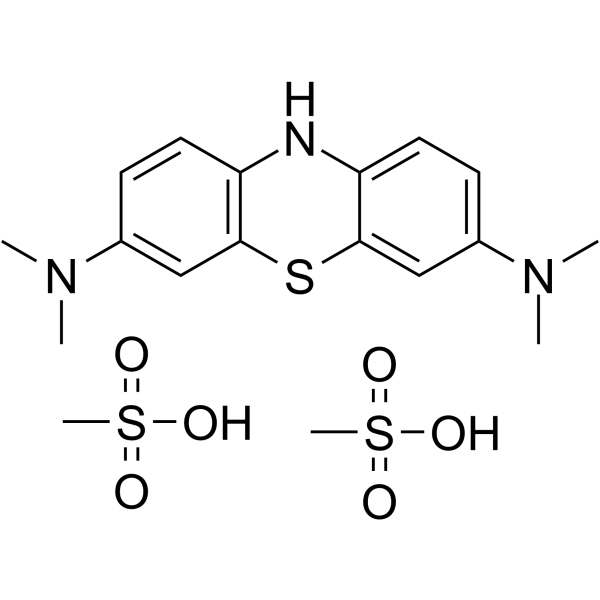Leucomethylene blue mesylate;(Synonyms: TRx0237 mesylate; Methylene blue leuco base mesylate) 纯度: 98.75%
Leucomethylene blue (TRx0237) mesylate 是具有口服活性的二代 tau 蛋白聚集的抑制剂 (Ki 值为0.12 μM),可用于阿尔兹海默症的研究。Leucomethylene blue mesylate 是 Methylene blue (亚甲基蓝)的一种还原形式, 亚甲基蓝是一种化学指示剂和生物染色剂。

Leucomethylene blue mesylate Chemical Structure
CAS No. : 1236208-20-0
| 规格 | 价格 | 是否有货 | 数量 |
|---|---|---|---|
| Free Sample (0.1-0.5 mg) | ; | Apply now | ; |
| 10;mM;*;1 mL in DMSO | ¥660 | In-stock | |
| 5 mg | ¥600 | In-stock | |
| 10 mg | ¥780 | In-stock | |
| 50 mg | ¥2300 | In-stock | |
| 100 mg | ¥4200 | In-stock | |
| 200 mg | ; | 询价 | ; |
| 500 mg | ; | 询价 | ; |
* Please select Quantity before adding items.
Leucomethylene blue mesylate 相关产品
bull;相关化合物库:
- Drug Repurposing Compound Library Plus
- Clinical Compound Library Plus
- Bioactive Compound Library Plus
- Neuronal Signaling Compound Library
- Clinical Compound Library
- Drug Repurposing Compound Library
- Orally Active Compound Library
- Anti-Alzheimer’s Disease Compound Library
- Neurodegenerative Disease-related Compound Library
- Targeted Diversity Library
| 生物活性 |
Leucomethylene blue (TRx0237) mesylate, an orally active second-generation tau protein aggregation inhibitor (Ki of 0.12 μM), could be used for the study of Alzheimer’s Disease. Leucomethylene blue mesylate is a common reduced form of Methylene Blue, Methylene Blue is a member of the thiazine class of dyes[1][2][3]. |
IC50 Target |
Ki: 0.12 μM (tau)[3]. |
||||||||||||||
|---|---|---|---|---|---|---|---|---|---|---|---|---|---|---|---|---|---|
| 体外研究 (In Vitro) |
Leucomethylene blue (100 nM, 48 h) mesylate not only decreases the tau and p-tau expression levels, but also reversed the promoting effects of Aβ25-35 on orexin A and adenosine A1R expression levels[2]. MCE has not independently confirmed the accuracy of these methods. They are for reference only. Western Blot Analysis[2]
|
||||||||||||||||
| 分子量 |
477.62 |
||||||||||||||||
| Formula |
C18H27N3O6S3 |
||||||||||||||||
| CAS 号 |
1236208-20-0 |
||||||||||||||||
| 运输条件 |
Room temperature in continental US; may vary elsewhere. |
||||||||||||||||
| 储存方式 |
4deg;C, stored under nitrogen, away from moisture *In solvent : -80deg;C, 6 months; -20deg;C, 1 month (stored under nitrogen, away from moisture) |
||||||||||||||||
| 溶解性数据 |
In Vitro:;
DMSO : 110 mg/mL (230.31 mM; Need ultrasonic) H2O : 83.33 mg/mL (174.47 mM; Need ultrasonic) 配制储备液
*
请根据产品在不同溶剂中的溶解度选择合适的溶剂配制储备液;一旦配成溶液,请分装保存,避免反复冻融造成的产品失效。 In Vivo:
请根据您的实验动物和给药方式选择适当的溶解方案。以下溶解方案都请先按照 In Vitro 方式配制澄清的储备液,再依次添加助溶剂: ——为保证实验结果的可靠性,澄清的储备液可以根据储存条件,适当保存;体内实验的工作液,建议您现用现配,当天使用; 以下溶剂前显示的百
|
||||||||||||||||
| 参考文献 |
|
